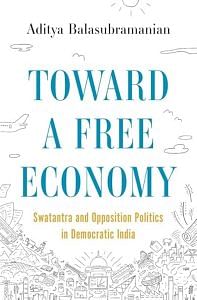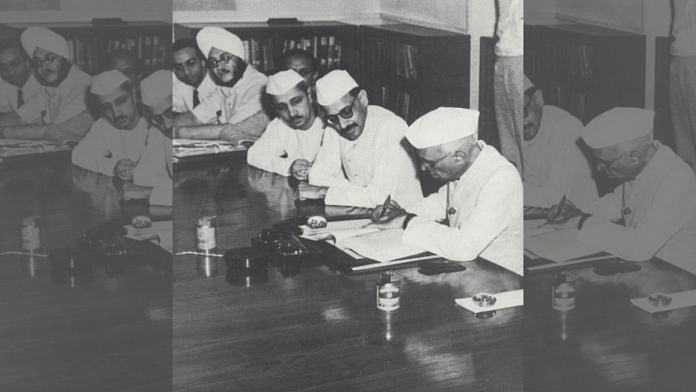India’s planning model aimed at consolidating a “mixed economy” with private and public sectors. But the aim was to move the country toward a “socialistic pattern of society,” as articulated by the Congress in 1955. The socialist tenor of this policy lay in the fact that 80 percent of the second plan’s resources were marked out for the public sector and that the nationalization of multiple industries was in the cards. The private sector received lower priority.
Instead of “socialist,” a better description would be an aspiring developmentalist state capitalism comprising state-owned firms and a regulated private sector. “Mixed economy” connoted the state ownership of priority sectors combined with private sector ownership of other sectors of the economy. The planners considered this a “middle way” in development, avoiding the extremes of either laissez-faire or complete state ownership of the means of production.
The strategy found acceptance and aid from both sides of the Iron Curtain. Indeed, a great contradiction of India’s capital-goods-led import substituting industrialization was that self-sufficiency involved becoming dependent on generous resource contributions from foreign countries. The largest donors were the United States and the Soviet Union. Both saw India as a crucial site in the global Cold War and sought to tilt the nominally nonaligned country in their direction. The Americans, advised by modernization theorists, sought to help give India a “big push” and become a major market for U.S. exports. The United States offloaded its agricultural surpluses onto food-insecure India and sought to persuade the country to dedicate greater resources to private sector and small industrial development. The Soviets, wanting India to industrialize so that its proletariat could develop and seize the means of production, provided resources in support of heavy industry products.
State propaganda vividly conveyed the ambition of the globally supported second plan, the centerpiece of India’s dominant economic imaginary. The Films Division released the Hindi-language Working for the Plan just before it commenced. The film begins with a postman delivering an invitation to a theater performance titled, Sāre Jahāṃ Se Accā, Hindustān Hamārā (Better than the Rest of the World, Our India). Named after a famous patriotic song, the play weaves planning into a history of India. This history commenced with ancient glory, followed by colonial decline. It ended in national regeneration built on the backs of a diverse group of peoples working together for the greater good. Near the end, the camera cuts from the ancient Ashokan wheel of the Indian flag to the turning gears of a machine, emphasizing the connection between the past and the aspired future. The narrator boldly proclaims, “Yah ek naye Bhārat banāne kā yojanā hai” (This is a plan to make a new India).
The second plan’s ambition and relative neglect of agricultural investment sowed the seeds of its demise. Shortages of foreign exchange and food put brakes on the process. The Third Five-Year Plan (1961–66) shifted the resources away from the public sector and more toward agriculture, even as it retained a slight heavy industry focus. A more decentralized process of resource allocation allowed state governments to pursue new policies to improve agricultural yields. Still, India persistently underproduced its targets. State-level resistance from landed interests on matters such as the reform of agrarian holding structures and production arrested further progress. While India’s new, world-class capital-goods-producing firms met their plan targets, older uncompetitive businesses churned out subpar consumer goods well into the 1960s.
Financial constraints now overwhelmed the heady dreams and enthusiasm characteristic of the earlier years of planning. India’s wars with China (1962) and Pakistan (1965) drove up military expenditures. A poor harvest in 1966 produced further economic pressures. By that year, India had steadily run out of foreign exchange and could no longer pay for imports. It was forced to devalue the rupee and liberalize import policy by the World Bank and International Monetary Fund to secure the requisite foreign exchange. The inflation rate was about 14 percent that year, ten times greater than the 1.5 percent annual average for the first half of the 1950s.
Such events undermined the original development strategy. Indian development planners lost autonomy to foreign interests, dropping several industrial controls and trade licensing policies. Over the entire third plan period, India’s economy grew at an annual average of just 0.3 percent.
The country subsequently went on a Plan Holiday from 1966 to 1969. In the face of sustained foreign pressure, Indian policymakers made virtue of necessity and articulated a new policy for agriculture. Lal Bahadur Shastri, Nehru’s successor, did not share his predecessors’ views on development. He showed more sympathy to private sector efforts and interests in the agrarian economy relative to heavy industry. From 1966–67, Indian policymakers embarked on what would come to be known as the Green Revolution. India introduced high-yielding varieties of seeds from Mexico and chemical fertilizers by providing price incentives to private farmers who would adopt them, aided by the Rockefeller Foundation. Farmers received direct payments for investment in improved agricultural technology under this scheme. By pursuing this strategy, India became self-sufficient in food production, ending a period of its economic history of persistently inadequate domestic food supply. However, the policies tended to concentrate power in the hands of rich farmers and clients of landowners and made increasing numbers of agricultural laborers redundant.
During the second half of the 1960s, the Center conceded greater resources to the states and left more activity to the private sector. The liberalization of certain forms of licensing and removal of controls from strategic industries compromised the “planned” character of the economy. Once seen as the formidable agent of industrial transformation, the public sector lost its widespread regard. Even the Soviets, who welcomed India’s aim of public-sector-led development, grew frustrated with the inefficiency of the country’s public enterprises. The introduction of greater price incentives for farmers and the slow retreat of the state from primary markets in agriculture signaled the end of an era. Turning things over to the states and private markets was a fresh approach.
Planning ended two hundred years of per capita income stagnation for good. The Indian economy slowly but surely moved away from agriculture and toward heavy industrial production. India’s industrial sector grew at 7 percent annually. The composition of this growth moved away from consumer goods and into capital goods production. Planning also shifted the balance between private and public sectors. The public sector’s share of national output rose from 7.4 percent to 13.3 percent between 1950 and 1965. At the same time, the independent Indian state failed to achieve its aims. The capital-intensive techniques of planning generated inadequate employment for India’s population, which grew 70 percent between 1941 and 1971 thanks to declining death rates. And growth exacerbated vectors of both economic and social inequality such as income, gender, and caste.
 Excerpted from TOWARD A FREE ECONOMY by Aditya Balasubramanian. Copyright © 2023 by Princeton University Press. Reprinted by permission.
Excerpted from TOWARD A FREE ECONOMY by Aditya Balasubramanian. Copyright © 2023 by Princeton University Press. Reprinted by permission.



